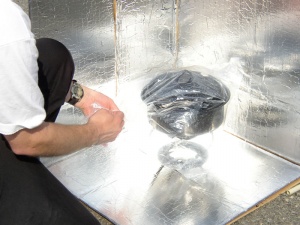EDUC 6470 Week 10
Using technology in the classroom
Using HOBO data loggers live in the class
- Light
- Temperature
- Acceleration
Activity for April 7
- Meet in Mann Library Computer Lab B30A.
- Launch HOBO measuring temperature and light in lab every 15 seconds for next 20 minutes.
- Split class into diverse pairs; some pairs will use teacher-determined questions, some will generate their own questions. We may use the following matrix, or have more subtle differences between groups (see #Pairs list below):
| Questions about nachos in solar cooker | Questions about water in solar cooker | Questions about HOBO | |
|---|---|---|---|
| Answer
given questions |
Pair 4,5,6,7 | Pair 8,9 | |
| Generate
own analysis |
Pair 2, 3 | Pair 8,9 | Pair 1 |
| Generate
own questions |
Pair 2, 3 | Pair 1 |
- Have pairs report to whole group findings and perhaps relevant learning issues
- Get data from logger
- Apply lessons from discussion to this new data set as a whole class.
Files
- media:LightTempSolBQ20090416-2.pdf
- http://shawnreeves.net/documents/NachoCookerTempLight.xlsx
- http://shawnreeves.net/documents/SolCookCloudyFrigid300mlWater.xlsx

General information
- This HOBO was placed inside an aluminum pan with 40 tortilla chips and 200g of cheese; the pan was placed on a stand and in a thick, clear, plastic bag; that apparatus was placed in a large three-panel reflector facing the sun.
- Bright sunlight in April in Ithaca amounts to about 700W/m2.
- The specific heat capacity of cheese and tortilla chips is roughly half that of water.
Pairs
- Note--You have only 5 minutes for your analysis, then you will give a 1 minute oral report to the whole class of your findings.
- Develop a study to determine the thermal mass of a HOBO.
- Freely interpret printout of LightTempSolBQ20090416-2.
- Freely interpret LightTempSolBQ20090416-2 in Excel.
- Answer questions (ONLY THIS PAIR MAY CLICK ON THIS LINK) about printout of LightTempSolBQ20090416-2.
- Answer questions (ONLY THIS PAIR MAY CLICK ON THIS LINK) about LightTempSolBQ20090416-2 in Excel.
- Read text Determining the ultimate temperature of a solar cooker and determine the ultimate temperature according to readings at about 2:15 and 2:45, using LightTempSolBQ20090416-2 in Excel.
- Read text Determining the ultimate temperature of a solar cooker and determine the ultimate temperature according to readings at about 2:15 and 2:45, using a straight-edge, paper, and pencil and a printout of LightTempSolBQ20090416-2.
- Look at SolCookCloudyFrigid300mlWater.xlsx in Excel. Determine whether the water would have been pasteurized had there been no clouds.
- Using a printout of SolCookCloudyFrigid300mlWater.xlsx, a straightedge, and a pen/pencil, determine whether the water would have been pasteurized had there been no clouds.
Discussion topics
- Barak, page 218, on CBL and Real-Time Graphing:Computer taking tables of data and creating graphical analyses allows students more time for more rigorous analysis and inference.
Different ways students can get active with the technology, for the purposes of learning science, not just the technology
Measure something arbitrary
- With accelerometer, measure acceleration while spinning.
Measure something historically important to science
- Measure change in temperature of a calorimeter.
Measure something important to current science
Measure something important to the teacher's research
Measure something important to the students or to the community
Readings
- Barak (2006)
When Miri Barak starts the article, the first subject is the use of internet for lessons and the instruction of how chemists use the internet. My reaction is that the internet, in this light, may be seen as opposite to innovation, allowing undergraduate instructors to shunt readings away from costly textbooks, lectures away from costly lecture halls, labs away from costly physical laboratories, and homework clerical work away from costly teaching assistants, thereby maintaining the tradition of readings, lectures, labs, and problem sets. So I agree with Barak that "integrating technology in a coherent and authentic way into curricula is a significant ... challenge." (p. 216) But I would specify that one of the challenges is to take proper advantage of technologies instead of using them as a crutch for crippled traditions.
In enumerating the examples of diverse valuable lessons using information technology, Barak makes me think that we might make a Survey of pedagogical qualities that would act as a guide and an assessment of the pedagogical value of a lesson.
I think Bill Gates, in lobbying and setting the tone for computers-in-the-classroom policies for over 20 years now, along with computer makers and PASCO and Vernier, has carefully crafted a tone of discourse, something like "lets' talk about all the awesome things we can do with information technology," allowing some "but it has to be used properly." What's lacking is enough skepticism besides the inertial impediments to using more information technology. Why not research the improper uses more closely, to see why we do wrong and what leads us to do wrong? I wonder whether Gates et al. have made us afraid to ask?
- French (2006)
Wow, Donald French really hits it for me, immediately bemoaning the facility in computer presentations to make information presentation even more didactic and hard-to-follow. (p. 223)
- Champion & Novicki (2006)
- Mantei (2002)
Notes from class
Amanda presented a geoscience-education helpful site, "On the Cutting Edge": http://serc.carleton.edu/NAGTWorkshops/ and http://serc.carleton.edu/sp/index.html